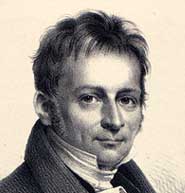- Henrik Steffens
Infobox Scientist
name = Henrik Steffens
box_width =
image_width =150px
caption = Henrik Steffens
birth_date =May 2 1773
birth_place =Stavanger, Norway
death_date =February 13 1845
death_place =
residence =
citizenship =
nationality = Norwegian
ethnicity =
field = philosopher
work_institutions =
alma_mater =
doctoral_advisor =
doctoral_students =
known_for =
author_abbrev_bot =
author_abbrev_zoo =
influences =
influenced =
prizes =
religion =
footnotes =
Henrik Steffens (May 2 1773 –February 13 1845 ), was a Norwegian-born philosopher, scientist, and poet.He was born at
Stavanger, Norway . At the age of fourteen he went with his parents toCopenhagen , where he studiedtheology andnatural science . In 1796 he lectured at theUniversity of Kiel , and a year later went to theUniversity of Jena to study the natural philosophy ofFriedrich Schelling . He went toFreiburg in 1800, and there came under the influence of Friedrich Werner.After two years he returned to Copenhagen, and is said to have introduced
German romanticism to Denmark in 1802 with nine lectures given atValkendorffs Collegium , later published as "Indledning til philosophiske Forelæsninger" ("An Introduction to Philosophical Lectures"). These lectures were a great success and a source of inspiration in Danishromanticism . They were attended by many who would later become leading Danish thinkers, such as Oehlenschläger and Grundtvig.Friedrich Schleiermacher was so much struck by their excellence that he endeavoured, unsuccessfully, to obtain for Steffens a chair in the newBerlin University in 1804, in order that his own ethical teachings should be supported in the scientific department.Despite – or perhaps because of – the deep impact made by his lectures, Steffens was not made welcome by the Danish authorities. He moved back to Germany and took up a professorship at the
University of Halle in 1804, to return to Denmark only occasionally. During theWar of Liberation he served as a volunteer in the cause of freedom, and was present at the capture of Paris. From 1811 he was professor of physics atBreslau until 1832, when he accepted an invitation toBerlin .Steffens was one of the so-called "Philosophers of Nature", a friend and adherent of Schelling and of Schleiermacher. More than either of these two thinkers he was acquainted with the discoveries of modern science, and was thus able to correct or modify the highly imaginative speculations of Schelling. He held that, throughout the scheme of nature and intellectual life, the main principle is
Individualisation . As organisms rise higher in the scale of development, the sharper and more distinct become their outlines, the more definite their individualities. This principle he endeavoured to deduce from his knowledge ofgeology , in contrast toLorenz Oken , who developed the same theory on biological grounds. His influence was considerable, and both Schelling and Schleiermacher modified their theories in deference to his scientific deductions.His chief scientific and philosophical works are:
*"Beiträge zur inneren Naturgeschichte der Erde" (1801)
*"Grundzuge der philosophischen Naturwissenschaft" (1806)
*"Anthropologie" (1824)
*"Ueber die idee der Universitäten" (1835)
*"Ueber geheime Verbindungen auf Universitaten" (1835)
*"Karikaturen des Heiligsten" (1819-1821)
*"Wie ich wieder Lutheraner wurde and was mir das Luthertum ist" (1831)
*"Von tIer falschen Theolegie und dem wahren Glauben" (new ed., 1831)
*"Die Familien Walseth" and "Leith" (1827)
*"Die vier Norweger" (1828)
*"Malcolm" (1831)During the last five years of his life he wrote an autobiography, "Was ich erlebte", and after his death his "Nachgelassene Schriften" (1846) was published. See Tietzen, "Zur Erinnerung an Steffens"; Petersen, "Henrik Steffens" (German translation, 1884); Dilthey, "Leben Schleiermachers".
References
*1911
Wikimedia Foundation. 2010.
